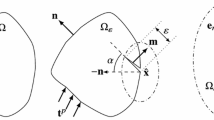Abstract
A Barenblatt model of the dissipative region at the edge of a mode I crack under small scale yielding is established, so that stress gradient and displacement gradient continuity prevail along the symmetry plane. The resulting model thus connects smoothly to adjacent material and it displays exceptionally smooth opening.
Similar content being viewed by others
REFERENCES
Andersson, H. (1975). Finite element methods applied to problems of moving cracks. Computational Fracture Mechanics. The American Society of Mechanical Engineers, New York, 185-198.
Barenblatt, G.I. (1959). Concerning equilibrium cracks forming during brittle fracture. The instability of isolated cracks, relationship with energetic theories. J. Appl. Math. Mech., 23, 1273-1282. English translation from PMM, 23 (1959), 893-900.
Broberg, K.B. (1975). On stable crack growth. J. Mech. Phys. Solids 23, 215-237.
Broberg, K.B. (1996). The cell model of materials. Computational Mechanics, 19, 447-452.
Broberg, K.B. (1999). Cracks and Fracture, Academic Press, London.
Ståble, P. (1985). Process region characteristics and stable crack growth. Report LUTFD2-/(TFHF-5019) from Division of Solid Mechanics, Lund Institute of Technology, Lund, Sweden.
Author information
Authors and Affiliations
Rights and permissions
About this article
Cite this article
Broberg, K.B. A Smooth Dissipative Region Model. International Journal of Fracture 113, 3–8 (2002). https://doi.org/10.1023/A:1022683732121
Issue Date:
DOI: https://doi.org/10.1023/A:1022683732121




